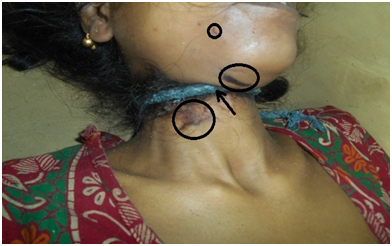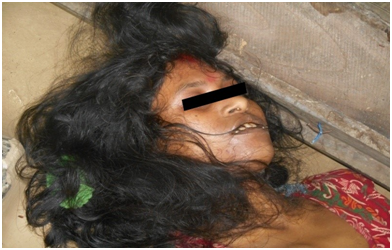eISSN: 2469-2794


Case Report Volume 8 Issue 1
Biology/Serology Division, Tripura State Forensic Science Laboratory, India
Correspondence: Dr. Sabyasachi Nath, Biology/serology Division, State Forensic Science Laboratory, Tripura–799015, India, Tel 0381-234-1266
Received: December 19, 2019 | Published: January 14, 2020
Citation: Nath S, Majumder R, Pratihari HK. Homicide hanging–a rare case report. Forensic Res Criminol Int J. 2020;8(1):8-9. DOI: 10.15406/frcij.2020.08.00301
There is alarming number of suicide hanging cases reported belonging to different age groups. It is seen from a large number of case studies that the suicide hanging is preferred by the victims to end life for various reasons. But homicide hanging is rarely reported due to easy detection of physical evidence manipulated on the hanging spot and also by autopsy study. There is no much literature available under such crime-head. In one case, an FIR was lodged about hanging of a woman from bamboo ceiling in her dwelling house. The investigating officer and forensic team immediately visited the crime spot. In the meantime, the husband could simulate suicidal hanging and misled the investigative team stating to have cut the rope (ligature material) to bring down for saving the hanging victim. Further, one torn end rope found around her neck and the other cut end (terminal) hanging from the bamboo ceiling. The crime scene was disturbed. Moreover, absence of any supporting evidence to reach the hanging point by the victim to tie the rope was also doubtful. The accused suppressed the crime simulating a case of suicidal hanging to get away from punishment. However, the analysis of the ligature mark, anti-mortem injuries on the neck and post-mortem symptoms on the victim as well as circumstantial evidence found on the crime spot could rule out the possibility of suicidal hanging. Further, autopsy study also supported homicide beyond doubt. The details have been discussed including the verdict of judgement of the Hon’ble Court.
Keywords: Hanging, Homicide, Ligature material, Symptoms, Injuries, Autopsy study
There are various methods adopted to commit suicide. The hanging is commonly reported in suicidal cases for various reasons: (i) easy to end life without much pain, (ii) takes less time, (iii) easy to select place indoor/outdoor, (iv) easy availability of hanging material, (v) does not require much preparation or skill, etc. Taking advantage of such modus operandi, the potential criminal sometimes creates a scene of hanging or drowning after murder to mislead the investigating agency to escape from the crime. As per National Crime Records Bureau (NCRB), Ministry of Home Affairs, Government of India data, every hour a student commits suicide in India.1 But homicidal hanging is rarely reported and sufficient literature is not available under such crime-head.
The fabrication of a crime scene after incidence is a complicated task and leaves behind some clues which subsequently help for detection of the crime. It needs skill/expertise on the part of investigating officer/and forensic expert for correct evaluation to come to conclusion. The careful examination of the hanging body and crime spot on the following points coupled with autopsy study are essential tools to establish simulated crime scene:2–5
An FIR (First Information Report) was received about hanging of a woman from the bamboo beam in her dwelling house. By the time investigating officer along with forensic team reached the crime spot, the husband (accused) simulated the crime scene claiming suicidal hanging and misled the investigative team stating to have cut the rope to bring down for saving the hanging victim. One torn rope was also found around her neck and the other cut end (terminal part) hanging from the bamboo beam. Further, absence of any support for the victim to reach the hanging point was also suspicious. The accused covered the crime simulating a case of suicidal hanging to get away from stringent punishment. However, the examination of the ligature mark, anti-mortem injuries on the neck and post-mortem symptoms on the victim as well as circumstantial evidence found on the crime spot could strongly rule out the possibility of suicidal hanging. Further, autopsy report also supported homicide beyond doubt.
Observations
The injuries and ligature mark with ligature material (nylon rope) tied around the neck are shown in Figures 1 and 2.

Figure 1 Circular, continuous, horizontal ligature mark with other injury marks(o) and ligature material (↑) tied around neck of the deceased.

Figure 2 Partially open eyes and mouth without protrusion of tongue and absence of dribbling saliva.
Autopsy study
External: The deceased was about 28 year old female of average built. One ligature mark was present encircling the neck.
Internal: The brain, spinal cord, larynx, trachea, lungs, pericardium, heart, liver, spleen, kidneys were found congested. The uterus was found empty.
Injuries: Deformity of 3rd and 4th right ribs at mid clavicular lining. A deep, transverse ligature mark was present above the thyroid cartilage encircling the neck. Bruising and abrasion are present on left side and in front of the neck about the edges of the ligature mark. Superficial mark of knot is present on the left side of neck.
The cause of death is asphyxia following compression of neck which is homicidal in nature. Further, toxicological analysis of viscera and body fluid ruled out the presence of poison and intoxicants in this case.
Forensic evidence observed on the spot
The above observations on the body of the victim and the crime scene do not support the theory of suicidal hanging.
In most of the homicidal hanging cases the accused prepare the scene appearing like suicidal hanging in order to misguide the investigator. This is a similar case where the accused (husband) killed his wife in presence of minor son (when asleep) at night on the day of occurrence, the cause being family dispute. In order to suppress the crime, the accused concealed the fact and simulated the scene to be a suicidal hanging to cover the crime. But forensic investigation coupled with autopsy study proved to be a case of homicide. The case ended in conviction based on forensic evidence, autopsy findings and circumstantial evidence.
None.
None.
The author declares there are no conflicts of interest.

©2020 Nath, et al. This is an open access article distributed under the terms of the, which permits unrestricted use, distribution, and build upon your work non-commercially.